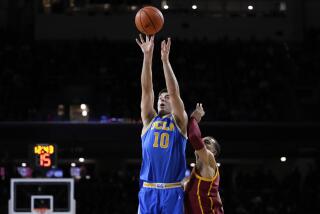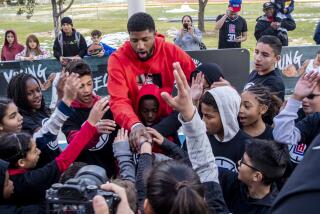COLLEGE BASKETBALL ‘92-93 : A Big Shot : Surgery Didn’t Stop Haskin, 6-11 With a Feathery Touch
- Share via
CORVALLIS, Ore. — Larry Bird, Vlade Divac, Moses Malone. That’s good company for a 22-year-old basketball player.
Except when the common thread is back surgery.
Scott Haskin, Oregon State’s center, remembers how the pain began in earnest after an awkward landing during a pickup game his sophomore year. It started as a backache and got worse.
“Back pain is very deceptive,” he said. “Sometimes you think you’ll be all right, and other times you’ll be on your deathbed, so to speak. You don’t want to get up and do anything.”
The pain spread and when his leg went “limp” one day in 1990, Haskin was terrified. In August of that year, he underwent surgery for a herniated disk in his lower
back, knowing he would miss an entire basketball season.
“At the time, I couldn’t have cared less about basketball,” said Haskin, who says he had the surgery in Portland partly because the hospital in Corvallis couldn’t accommodate his 6-foot-11 frame. “I was fully prepared to give up basketball if that was the case. I just wanted to be able to lead a normal life.”
Haskin says he has recovered fully. But the likelihood of his leading a normal life--the sort that doesn’t include early-morning plane flights in the NBA--began to diminish last season. In consecutive games, he had 24 points and 11 rebounds against UCLA, 33 points and 10 rebounds against USC and 22 points and 11 rebounds against Washington State.
Against USC, Haskin’s soft shooting touch and deadly turnaround jump shot were near their best. He made 12 of 16 shots--including his final 10 in a row--in an upset of the Trojans, then ranked 13th in the nation.
“Of all the big kids we faced last year, he gave us more problems than any of them,” USC Coach George Raveling said. “Some of those, Matt Geiger from Georgia Tech, Sean Rooks from Arizona, are in the NBA now. We couldn’t contain him.”
Haskin remains relatively unheralded, but in a Pacific-10 Conference that lost many of its stars after last season, he may be its best player, with competition from Arizona’s Chris Mills and California freshman Jason Kidd.
Remarkably, Haskin isn’t the only center in the conference who has surgical scars on his back. Richard Petruska, who is starting for UCLA after transferring from Loyola Marymount, had part of a disk removed last March but returned this season and scored 21 points in UCLA’s opening game.
At Oregon State, another player was not so successful.
“One of my own teammates, Chris Rueppell, he had his second back surgery before I had my first,” Haskin said. “He had to quit. It got the best of him. The pain, and the second time through surgery on the same disk, kind of took its toll.”
Surgeon William Carr attributes Haskin’s success to his diligent rehabilitation. Although more and more athletes are returning to their careers after such surgery, there are no givens.
“I think if you took 10 athletes who had the same injury, one or two would not get back to their former level,” Carr said.
Haskin, who grew up in the California desert town of Beaumont, is drawing more attention than he has since high school, when 6-2 defenders clung to him futilely as he scored 58 points in the 1988 Southern Section Division 1-A championship game.
Until he got a letter from UCLA as a high school junior, he thought his next school would be the Arizona Automotive Institute, where he planned to train as a mechanic.
“You know, for a kid who was getting recruited by no one to getting a letter from UCLA, saying they were interested, it kind of gave me an alternative route to life,” Haskin said. “I hadn’t really planned on going to college. The opportunity presented itself, and I was going to take it.”
He almost went to Syracuse, then changed his mind and picked Oregon State.
Haskin wasn’t an immediate success in Corvallis, averaging three points as a freshman and eight as a sophomore. But he returned last year after the surgery and averaged 18 points and 6.5 rebounds, and he led the Pac-10 with a 61.3% field-goal percentage and 2.2 blocked shots per game. His shooting touch is most in evidence around the basket, but he also shot 77.9% from the line.
Now, NBA scouts come to watch him practice. He’s considered the best center at Oregon State since Steve Johnson, a consensus All-American in 1981, and coaches around the conference praise him, saying he is a potential first-round draft choice. He has been named one of the 25 candidates for the John R. Wooden Award, the basketball equivalent of the Heisman Trophy.
“He redshirted with that back injury and that took him off the public scene,” Oregon State Coach Jim Anderson said. “I’ve seen his progress from high school to this point. He was like a young colt. All of a sudden, around the middle of last season, he became more of a thoroughbred.”
Haskin’s surgical-redshirt year actually proved beneficial.
“I think the maturity factor sets in,” Anderson said. “You’re away from the game, and while you’re convalescing, you get a look at it from a different perspective. You think, ‘If this had ended my career, how would I feel about it?’ If anything, that year off is a real maturing element.”
Haskin has been a hard worker since high school, when his typical summer day in Beaumont was spent in a stifling gym, perfecting his turnaround.
“I worked sometimes four to five hours a day, six days a week,” he said.
After his surgery, he worked harder.
“A lot of people just wrote me off, flat-out, after I had to have surgery,” he said. “I was pretty much a lost commodity. It really makes you mad that people are so willing to jump on and jump off the bandwagon without giving that person a fair shot.”
Extra hours in the weight room with teammate Brent Barry, one of the slender sons of Rick Barry, have helped Haskin grow to 245 pounds. He’s still no brute. This center is a shooter, not a banger.
“As much weight as I’ve put on, and as much banging as I intend to do, I’m still a finesse player,” said Haskin, who models himself after Kevin McHale.
“I think people put too much emphasis on being a Karl Malone. I think you lose the sport of basketball when you start throwing bodies around. I was taught to play in the middle, and that’s how I play. So regardless of whether I weighed 300 pounds, I’d still be a finesse player. That’s kind of been a stigma in a sense. But being a finesse player is becoming a lost art, it really is.”
He spent the summer working on a hook shot, another nearly lost art. His tutor was Frank Morris, a former Oregon State track coach who is a meticulous teacher of the hook. It’s not a junior skyhook, but a swing shot that Haskin shoots with either hand. He used it effectively in the Beavers’ preseason scrimmage, and it adds one more shot to his effective array.
“If you play behind Scott and let him play with his back to the basket, he’s going to beat you,” Brent Barry said. “I know my dad has been impressed with Scott. He came up and watched us play and thought Scott had better skills than some of the centers who were in the league last year who are in the NBA. Dad saw him this year and thought Scott had improved visibly and saw that he was bigger. He thinks the sky’s the limit for Scott.”
Haskin, strikingly modest, doesn’t talk comfortably about his ability.
“I don’t sprint like a deer or jump like a gazelle,” he said. “I hope I’ve got something, at least.”
His nature serves him well around the athletic department.
“He’s not a big shot,” Anderson said. “In some aspects, he might be naive, maybe, but it’s refreshing. Whenever some people have had notoriety for a long time, they get callous to the situation because they become maybe a little bit of a prima donna. He does not get provoked when people want to talk to him. He’s not one of these players who brush people off as if to say, ‘You’re a bother and my time’s too precious.’ ”
The last few months have brought Haskin more attention than he has ever known.
“In one sense it’s nice, you know, to have the magazines, maybe show them to your kids one day,” Haskin said. “I don’t take any of it to heart. That would be the death of me, in five seconds, if I really believed what they said.
“I’ve gone from here to here in two months without even doing anything. It’s really weird. It’s certainly the most exciting thing that’s happened in my life. It’s not something a lot of people get to experience. But you have to step back and take a reality check.”
Haskin got his biggest reality check on the operating table in 1990.
“I was lucky, really lucky to come back from it,” he said. “It’s kind of a risky procedure. If the doctor slips up and the scalpel scrapes a nerve, you could have a lot of damage, permanently. You could have a limp leg or a club foot.
“The doctors tell you this before the surgery. You can sense that whatever happens is basically what happens. But I figured, better that than live with the pain. So I took my chances and beat the odds.
Which were?
“They gave me a percentage, but I can’t remember what it was,” Haskin said. “I think I tried to forget.”
More to Read
Go beyond the scoreboard
Get the latest on L.A.'s teams in the daily Sports Report newsletter.
You may occasionally receive promotional content from the Los Angeles Times.










